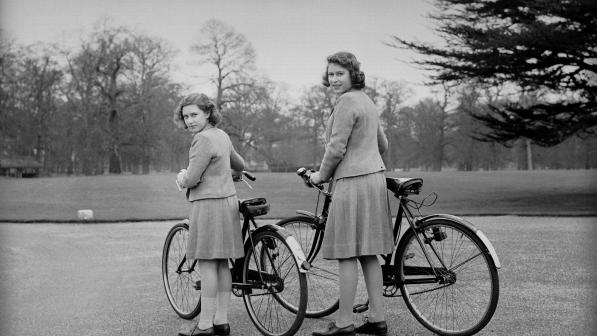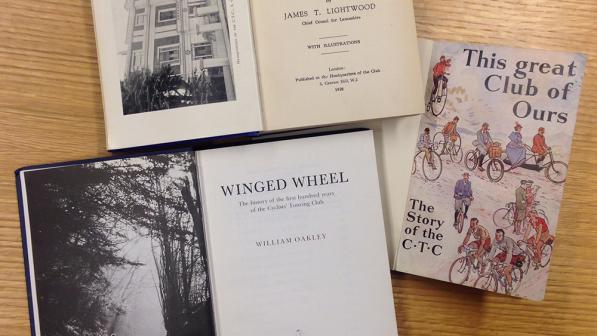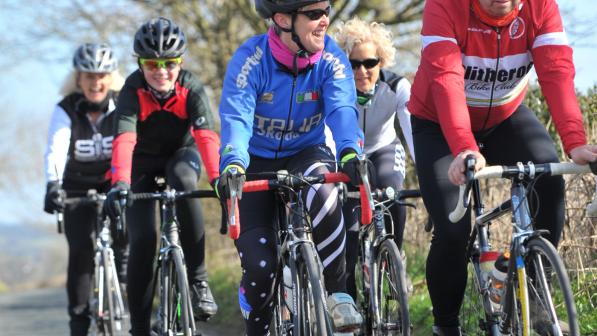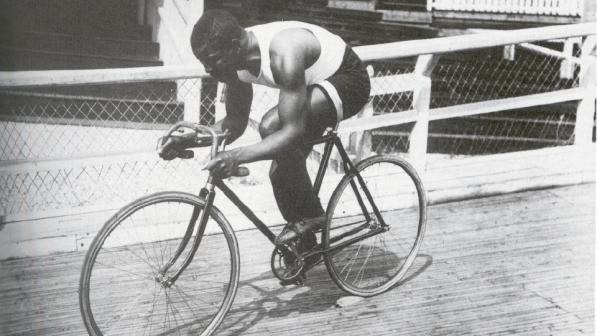Cycling UK history timeline
By Victoria Hazael

The Cyclists' Touring Club Gazette, October 1899
For more information on our history visit the Cycling UK archive at the University of Warwick.
You can view photographs, film footage and memorabilia from Cyclists' Touring Club.
There is also information on Cycling UK's history at The National Cycle Museum.

| 1878 | Bicycle Touring Club founded at Harrogate on Aug. 5th by Stanley Cotterell and 80 members elected. Oct. 15. First Monthly Circular issued. |
|---|---|
| 1879 | Hotel recommendations system introduced, Handbook and Guide first issued. Club uniform (green) adopted. |
| 1880 | First lady member (Mrs W. D. Welford) is admitted. Magazine re-styled as Monthly Circular and Official Gazette. |
| 1881 | Road routes first issued. |
| 1882 | Magazine title changed to Monthly Gazette and Official Record. |
| 1883 | Organization re-titled 'Cyclists' Touring Club'. Entrance fee instituted. Membership reached 10,627. Headquarters established at 139-140 Fleet Street, London EC4. |
| 1884 | 'Danger' road signs produced (at first jointly with National Cyclists' Union) mainly to warn of steep hills and down not up, due to the poor brakes of early bicycles. |
| 1885 | Richmond Park and Regents Park are the first of several royal parks opened to cyclists as a result of CTC action. Membership reached 20,385. |
| 1886 | Life Membership scheme inaugurated. New badge (CTC wheel and wings) adopted. |
| 1887 | The CTC incorporated (company limited by guarantee). Hotel signs adopted: those massive cast-iron winged wheels that may still be seen on the walls of old pubs etc. throughout the British Isles. |
| 1888 | Local Government Act declared cycles to be 'carriages' with right to use the roads as a result of CTC action. |
| 1889 | Foreign customs facilities first negotiated (waiving import tax for ridden bicycles when crossing borders). Continental Handbook started. Proposed amalgamation with National Cyclists' Union defeated at general meeting. |
| 1894 | First District Association (Northumberland & Durham) formed. |
| 1896 | CTC Headquarters moved to 47 Victoria Street, London SW. |
| 1897 | Membership reached 44,491. |
| 1898 | Touring Bureau established at CTC Headquarters. Reciprocal arrangements made with twelve Continental clubs. |
| 1899 | Lady Harberton, wearing 'rational' cycling dress, refused service at Hautboy Hotel, Ockham, Surrey. Case taken up by CTC, but lost. 'Cycles as rail passengers' luggage' test case lost. CTC coming-of-age dinner and organised tour. Membership reached highest ever: 60,449. CTC host to delegates in London for first annual congress of Ligue Internationale des Associations Touristes (forerunner of the AIT). |
| 1900 | CTC initiates joint venture with Messrs Bartholomew of Edinburgh to produce maps for cyclists of the whole of Great Britain, information on the condition of roads to be collated by CTC's network of Consuls. |
| 1901 | First Bartholomew/CTC half-inch to the mile map (sheet 3, the Lake District) is printed. |
| 1902 | Family and commuter membership schemes started. |
| 1906 | Application to re-name CTC 'The Touring Club' and amend constitution to admit all tourists, refused by the High Court. |
| 1907 | Club uniform abandoned. |
| 1909 | Affiliation scheme started. |
| 1910 | HM King George V became first Royal Patron of CTC. Headquarters moved to 280 Euston Road, London NW. Accident insurance scheme started. |
| 1913 | HRH the Prince of Wales (later King Edward VIII and subsequently the Duke of Windsor) became a Life Member of the CTC. |
| 1919 | Junior membership scheme adopted. |
| 1923 | 888 mile Relay Ride organised by CTC to convey message from Lord Mayor of London round England during National Bicycle Week. CTC representatives cycled to Buckingham Palace to give birthday greetings to their Patron, HM the King. |
| 1925 | Free Third Party Insurance scheme inaugurated. Cyclist's Diary first published in conjunction with Charles Letts & Co. Sir Alfred Bird Memorial Prize, endowed by his son (Sir Robert Bird, Bt), to be awarded for 'signal service' to the CTC during any year. Plaque offered by the CTC to the inventor or producer of the greatest improvement in cycle design, construction, or equipment during any year. |
| 1927 | Permanent headquarters purchased at 3 Craven Hill. London W2, and opened by the Duke of Argyll. Club colours (royal blue and old gold) adopted. Affiliated membership extended to schools and youth groups. |
| 1928 | Golden Jubilee dinner attended by the Earl of Birkenhead, the Rt. Hon. J Ramsay MacDonald, Sir John Foster Fraser, etc. 'Romance of the CTC' (history of the Club) by JT Lightwood published. 2052-mile Relay Ride organised by the CTC to convey birthday message to HRH the Prince of Wales round England and Southern Scotland. First Triennial Veterans' Ride (for male CTC members aged 50 and over). |
| 1931 | District Association runs lists issued as supplements to the Gazette. |
| 1934 | Defence Fund instituted. First 'Steep Hill' signs provided by CTC. |
| 1935 | 2215-mile Relay Ride to convey Silver Jubilee greetings to HM the King. Code of conduct ('Cyclists Take Care') published. |
| 1936 | King George VI became Patron following the death of George V and abdication of Edward VIII. Certificate of Merit award established. Distribution of 'Cyclists Take Care' leaflets reached five million. |
| 1938 | Diamond Jubilee rally at Harrogate. |
| 1944 | Sixth Triennial Veterans' Ride. CTC members received in Windsor Home Park by the Royal Family. |
| 1945 | First York Rally held as a get-together of Yorkshire CTC District Associations. |
| 1946 | Benefits of Junior membership extended to include the Gazette. |
| 1948 | Fourth York Rally and international event, celebrating CTC 70th anniversary and AIT Golden Jubilee. 'Candidates for membership' lists ceased to be published in the Gazette. |
| 1949 | 'Affiliation' scheme restricted to schools and youth groups only. |
| 1950 | CTC obtained removal of clause in Wolverhampton Corporation Bill which sought power to control cyclists' use of local roads. Membership reached post-war peak: 53,574. |
| 1951 | Competition to design 'ideal touring bicycle' organised by the Gazette and BSA Cycles Ltd. First CTC Organised Tour using air travel (to Switzerland). |
| 1952 | Death of King George VI. HM Queen Elizabeth II became Patron. British Cycle Tourist Competition inaugurated. CTC sued by J Cecil Paget Ltd. for breach of contract in refusing to insert their advertisements in the Gazette after complaints by members. |
| 1953 | 75th anniversary celebrations include re-enactment of Edinburgh to Harrogate foundation ride by Stanley Cotterell, on a High Ordinary bicycle, and unveiling of commemorative plaque in Harrogate. This Great Club of Ours (history of the CTC) published. 9th Triennial Veterans' Rides is first to be held in the north. DAs' runs lists ceased to be published nationally. |
| 1954 | AGM in Newcastle, in recognition of Diamond Jubilee year of the first CTC District Association (Northumberland & Durham). York Rally officially adopted as CTC annual National Rally. British Cycle Tourist Competition (3rd) is televised for first time. |
| 1955 | First CTC Youth Adventure Week. First 'Cyclists' Special' rail excursion organized by CTC. |
| 1956 | Free Third Party Insurance made worldwide and extended to £10,000. |
| 1957 | 'Associate membership' class inaugurated for children under 15 passing an approved cycling proficiency test. |
| 1958 | Eightieth anniversary celebrations. Floral designs in many towns. Extensive press, Radio and TV coverage. 14th York Rally an international event again. |
| 1959 | 11th Triennial Veterans' Ride; women accepted for first time. Recruitment competition inaugurated. Scheme re-instated for revision of Bartholomews half-inch maps by CTC. |
| 1960 | 16th York Rally is focal point of British Cycle Industries Association Golden Jubilee. |
| 1962 | Triennial Veterans' Rides (12th) are held for first time in three different areas. Membership Survey begun. |
| 1963 | The Gazette re named Cycletouring, published alternate months from December and made available by subscription to non-members. |
| 1964 | Entrance fees abolished. New under-18 Associate membership replaced the previous associate and youth group affiliation schemes. |
| 1965 | Rest All-Rounder competition for CTC time-trialists begun. Field Officer scheme began. 13th Triennial Veterans' Rides held in four areas. 21st York Rally, again an international event. Metal-plate road markings abolished by government after long campaign by CTC. |
| 1966 | Ist National Prize Presentation Dinner. National Headquarters moved to 69 Meadrow, Godalming, Surrey (named 'Cotterell House' after the Founder). Travel and enquiry office opened, 13 Spring Street London W2. Revised Memorandum of Association approved. |
| 1967 | Consular system discontinued. Local Information Officers appointed. 'CTC Travel Ltd' registered as a trading company. |
| 1968 | Right to cycle on bridleways and long-distance cross-country routes incorporated in new Countryside Act, largely through CTC action. |
| 1969 | Poll of whole Club confirmed AGM decision to raise subscription rates. 'Honorary' Vice-Presidents (i.e. without ex-officio seats on Council) first appointed. Silver Jubilee of the York Rally. |
| 1970 | CTC Handbook first offered free to new members. New group affiliation scheme introduced. Explanatory sub-title 'the cyclists association' adopted for publicizing CTC's protection work. Birthday Rides inaugurated from Cotterell House. |
| 1971 | 15th Triennial Veterans Rides held in five areas now including Scotland. |
| 1972 | Free Third Party Insurance cover increased to £50,000. CTC-organised international rally based on Loughborough. |
| 1973 | First award of new Merit Medallion for distinguished service to CTC. First lady Chairman of CTC Council elected (Mrs Ivy Thorp). Cyclists Diary re-styled and published direct from CTC Headquarters. |
| 1974 | Free Third Party Insurance cover increased to £250,000. |
| 1975 | First CTC 'transatlantic' Organised Tour (to Western Canada). CTC Handbook offered at half-price to new members (free issue discontinued). |
| 1977 | The Cycle Touring and Countryside Trust formed by the CTC and registered as a Charity. Free Third Party Insurance cover increased to £300,000. Cycles carried free (with certain exceptions) on trains after 99 years of sustained CTC effort. |
| 1978 | Centenary year: many press, radio and TV features. Dinner in London; Relay Ride through England, Wales Ireland, Scotland; AIT International Cycling Rally and 100th Birthday Rides based on Harrogate the Club's birthplace. Books: 'Winged Wheel' (history of the Club) and 'A Centenary Route' published. |
| 1979 | First Tour Leaders' course held. |
| 1980 | CTC Route Guide to Cycling in Britain & Ireland' published. Cycletouring magazine adopted regular full-colour front covers. Sale of CTC Travel Ltd severed that company's direct links with the Cyclists' Touring Club. Free Third Party Insurance cover increased to £500,000. |
| 1996 | CTC plays an instrumental role in developing the National Cycling Strategy |
| 2001 | The club sets up the Cyclists' Defence Fund to fight for cyclists' rights in the courts. |
| 2007 | Fill That Hole is launched. |
| 2011 | CTC becomes a charity in Scotland. |
| 2012 | CTC becomes a charity in England and Wales. The Cycle Touring and Countryside Trust is renamed Cycling History and Educational Trust (CHET) (Charity number 272792) |
| 2014 | CTC successfully campaigns for the Secretary of State for Transport to set out a strategy for cycling and walking infrastructure, and, by law, provide the funding required to meet it. |
| 2016 | CTC is rebranded to Cycling UK |
| 2018-19 | Cycling UK’s Cycle Friendly Employer Scheme launched and we won our Trails for Wales campaign. 150 women rode on the houses of parliament to mark the Women’s festival of cycling. |
| 2020 | Response to Covid-19- Big Bike Revival for Key workers launched as well as the flagship Cycle Repair Scheme in Scotland offering over 30,000 free bike repairs. |
| 2021 | Campaigned alongside Pedal on and millions of others at the COP26 summit to tell governments that cycling offers huge potential to cut climate emissions, and that active travel must be urgently embraced as part of the solution to the climate crisis. |






